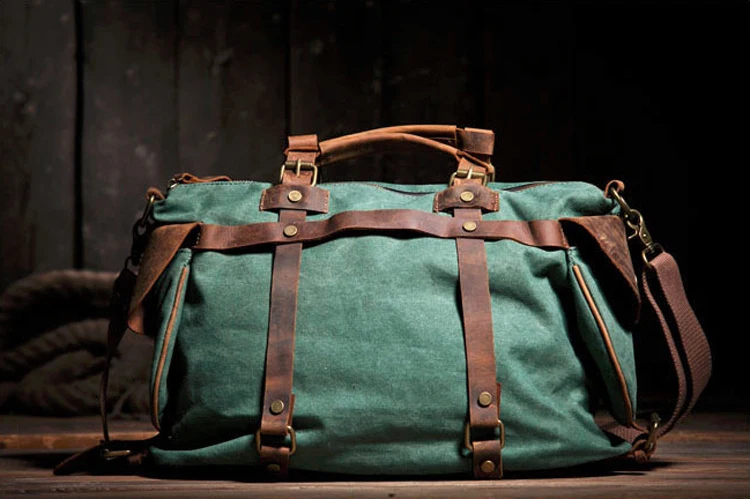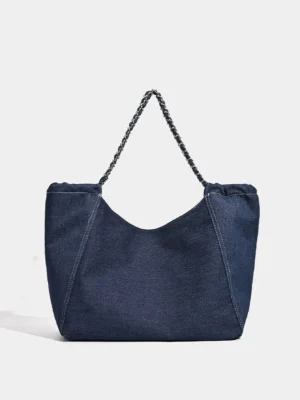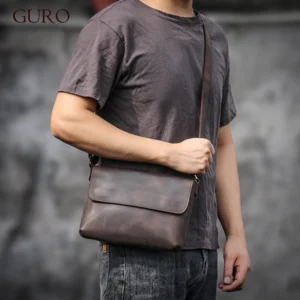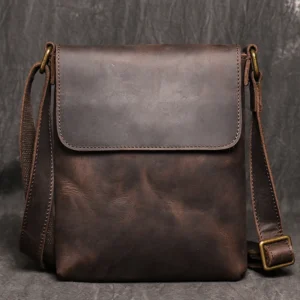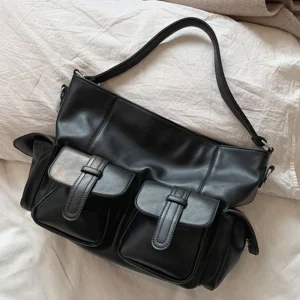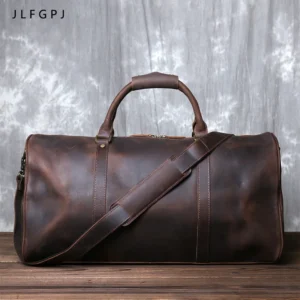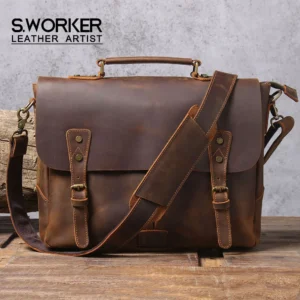Introduction: The Timeless Debate of Canvas vs Leather Messenger Bags
Selecting the right messenger bag is much more than a simple purchase decision—it’s an investment in your daily comfort, professional image, and personal style. At the heart of this choice lies one fundamental question: canvas or leather? These two materials have dominated the messenger bag landscape for generations, each bringing distinct qualities to the table.
Both canvas and leather have rich histories in bag craftsmanship. Canvas bags trace their lineage to military and postal applications where durability and functionality were paramount. Leather bags, meanwhile, have been status symbols and professional accessories for centuries, prized for their elegance and longevity. Today, both materials remain premier choices for quality messenger bags, though for different reasons.
In this comprehensive guide, we’ll explore the unique characteristics that define leather vs canvas messenger bags. We’ll examine their distinctive properties, weigh their advantages and limitations, and provide practical maintenance advice. By understanding which material might be better for your particular lifestyle, preferences, and needs, you’ll be equipped to make a confident, informed decision that serves you well for years to come.
Understanding Canvas Messenger Bags: Versatility and Practicality
Canvas, at its core, is a plain-woven, heavy-duty fabric typically made from cotton or linen fibers. Its tight weave creates a sturdy material that’s been trusted for centuries in applications requiring strength and resilience. Modern canvas messenger bags come in several varieties, each offering slightly different properties and benefits.
Standard cotton canvas, typically ranging from 12oz to 24oz in weight (referring to the ounces per square yard), provides a balanced combination of durability and flexibility. Waxed canvas incorporates paraffin or beeswax treatments, enhancing water resistance and adding a distinctive weathered appearance that develops character over time. Blended canvas might incorporate synthetic fibers like polyester to improve specific properties such as UV resistance or colorfastness.
The texture of canvas messenger bags tends to be slightly rough yet comfortable, with a tactile quality that many users find appealing. The material has a casual, approachable aesthetic that fits perfectly in educational settings, creative workplaces, and everyday urban environments.
Canvas bags have a fascinating heritage rooted in utility. Military messengers relied on canvas bags during wartime for their ability to withstand harsh conditions while protecting important documents. Similarly, postal workers adopted canvas bags for their durability and practicality during daily delivery routes.
Many contemporary designs combine these materials in canvas leather messenger bags, creating hybrids that capitalize on the strengths of both materials.
The Advantages of Canvas Messenger Bags
Significantly Lighter Weight: Canvas messenger bags typically weigh 30-40% less than their leather counterparts. A standard 15-inch canvas messenger might weigh just 1.5-2 pounds empty, compared to 2.5-3.5 pounds for a similar leather bag. This weight difference between leather and canvas becomes increasingly noticeable during commutes or long days carrying your essentials.
Budget-Friendly Price Point: Canvas bags generally cost substantially less than leather options. Quality canvas messenger bags often range from $50-$150, making them accessible entry points into the premium bag market without requiring a major investment.
Exceptional Color Versatility: While leather typically comes in traditional earth tones and a few dyed options, canvas accepts dyes readily and can be produced in virtually any color imaginable. This makes canvas bags ideal for expressing personal style through bold colors, patterns, or even custom prints.
Simple Maintenance Requirements: Most canvas bags can be spot-cleaned with mild soap and water. Many are even machine washable (on gentle cycles), making routine maintenance remarkably straightforward compared to leather’s more complex care rituals.
Built-In Weather Resistance: Particularly with waxed varieties, canvas offers natural protection against light rain and environmental elements. Waxed canvas develops a unique patina over time that enhances rather than detracts from its appearance—many owners appreciate how their canvas bag “breaks in” with use.
Environmentally Conscious Option: Canvas derived from natural fibers like cotton and linen comes from renewable resources, and many manufacturers now offer organic or recycled canvas options for environmentally conscious consumers.
The Limitations of Canvas Messenger Bags
Less Formal Appearance: Canvas naturally projects a more casual vibe that may not align with formal business environments. In conservative professional settings, canvas bags might be perceived as too informal regardless of their quality or design.
Color Fading Concerns: Prolonged exposure to sunlight can cause canvas colors to fade over time, particularly with darker or more vibrant shades. This effect is less pronounced with naturally colored or waxed canvas but remains a consideration for long-term aesthetics.
Limited Structure: Canvas tends to conform to its contents rather than maintaining a rigid shape. Without internal reinforcement, canvas bags may sag or lose their intended silhouette over time, particularly when carrying heavier items.
Potential Absorption Issues: Untreated canvas can absorb liquids and odors more readily than leather. While this can be mitigated with treatments, it remains a vulnerability, especially in food-adjacent environments or rainy conditions.
Less Puncture Resistant: Though abrasion-resistant, canvas offers less protection against sharp objects than leather. Keys, pens, or other pointed items may potentially damage canvas fibers from within the bag if not properly stored.
Understanding these characteristics helps when choosing the best messenger bag material for your specific needs and preferences.
Understanding Leather Messenger Bags: Elegance and Longevity
Leather, essentially tanned animal hide, represents one of humanity’s oldest and most valued natural materials. Its transformation from raw skin to finished leather involves complex processes that have been refined over thousands of years, resulting in a material prized for its durability, flexibility, and aesthetic appeal.
Leather messenger bags come in several distinct grades, each offering different characteristics and quality levels. Full-grain leather, the highest quality, retains the hide’s entire grain layer with all its natural markings and fiber strength. Top-grain leather has had its uppermost layer sanded to remove imperfections, creating a more uniform appearance but sacrificing some durability. Genuine leather (despite its misleading name) comes from lower layers of the hide, while bonded leather consists of leather scraps bound together with adhesives.
The tactile experience of a leather messenger bag is distinctive and luxurious—smooth yet textured, soft yet substantial. New leather has a characteristic aroma that many find appealing, and quality leather develops a rich patina over time that tells the story of its use. The material naturally molds to the body when carried regularly, creating a custom fit that becomes increasingly comfortable.
Leather messenger bags often showcase traditional craftsmanship techniques that have remained largely unchanged for generations. Hand-stitching, burnished edges, and careful material selection reflect the artisanal heritage behind quality leather goods.
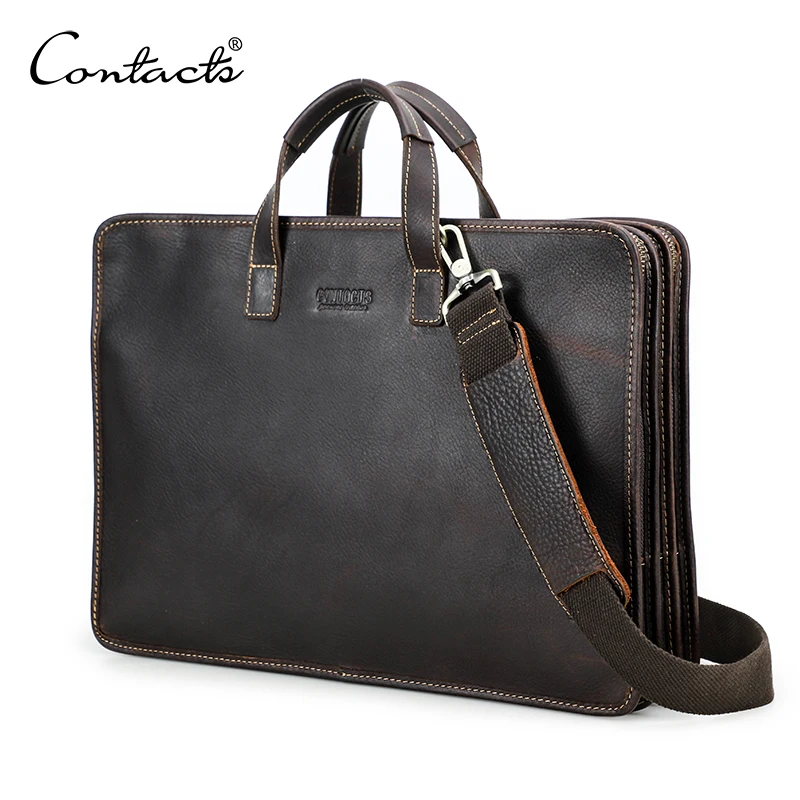
For those seeking the highest quality options, full-grain messenger bags offer unmatched durability and character development over years of use.
The Advantages of Leather Messenger Bags
Timeless Professional Appearance: Leather messenger bags project sophistication and executive presence. Their refined aesthetic seamlessly transitions from boardroom meetings to business travel, making them versatile professional accessories that enhance rather than detract from formal attire.
Exceptional Long-Term Durability: Quality leather bags can literally last decades with proper care. The natural fiber structure of leather allows it to withstand repeated flexing without breaking down, and many full-grain leather bags actually become stronger as their fibers compact with use.
Distinctive Aging Characteristics: Unlike synthetic materials that simply wear out, quality leather develops a patina—a beautiful burnished character that emerges through interaction with natural oils from hands, exposure to sunlight, and general use. This evolutionary aesthetic means your leather bag becomes uniquely yours over time.
Natural Water Resistance: Though not completely waterproof without treatment, leather’s natural oils provide inherent protection against light moisture. Water typically beads on quality leather rather than immediately soaking in, providing crucial moments to wipe it away before damage occurs.
Structural Integrity: Leather naturally holds its shape better than fabric alternatives. This structured quality not only looks more professional but also provides better protection for electronic devices, documents, and other valuable contents.
High-Value Perception: Leather messenger bags retain their perceived value remarkably well compared to other materials. A well-maintained leather bag can look premium for many years, continuing to make a positive impression long after purchase.
Sensory Appeal: Beyond visual aesthetics, leather engages multiple senses—the distinctive smell, the supple feel, and even the subtle sound of quality hardware against leather creates a multisensory experience that many users find deeply satisfying.
The Limitations of Leather Messenger Bags
Higher Initial Investment: Quality leather messenger bags typically start around $200 and can easily exceed $500 for premium options. This price point reflects the material quality and craftsmanship but represents a significant upfront cost compared to canvas alternatives.
Weight Considerations: Leather’s density makes it inherently heavier than canvas. A typical leather messenger bag might weigh 1-2 pounds more than its canvas equivalent before adding any contents. This additional weight can become noticeable during commutes or extended carrying periods.
Ongoing Maintenance Requirements: To preserve its appearance and extend its lifespan, leather requires regular care for your leather work bag. This includes periodic cleaning, conditioning every few months, and protection from extreme temperatures and direct sunlight.
Vulnerability to Scratches: While scratches eventually contribute to leather’s character, new scratches on pristine leather can be visually disruptive. Sharp objects, pet claws, and even fingernails can potentially mark leather surfaces.
Limited Color Options: Though leather can be dyed in various colors, the range remains more restricted than canvas. Additionally, vibrant colors in leather often require more maintenance to prevent fading or color transfer.
Ethical Considerations: For some consumers, animal-derived products present ethical concerns regardless of sourcing practices. This consideration may influence material choice regardless of other factors.
Direct Comparison: Canvas vs Leather Messenger Bags
When evaluating canvas versus leather messenger bags, understanding their performance across key criteria can help clarify which material might better serve your needs. The following comparison directly contrasts these materials in practical, everyday terms:
| Feature | Canvas | Leather |
|---|---|---|
| Weight | Lightweight (1.5-2 lbs empty) | Heavier (2.5-3.5 lbs empty) |
| Durability | High abrasion resistance; vulnerable to punctures | Excellent tear resistance; develops character from scratches |
| Water Resistance | Waxed canvas is highly water-resistant; untreated canvas absorbs water | Natural resistance to light moisture; needs protection from heavy rain |
| Maintenance | Simple spot cleaning; some are machine washable | Regular conditioning and specialized cleaning products required |
| Formal Appearance | Casual to business-casual | Business-casual to formal professional |
| Price Range | $50-150 for quality options | $200-500+ for quality options |
| Age Characteristics | May fade or fray over time | Develops rich patina and softens with use |
| Color Options | Unlimited colors and patterns | Limited primarily to earth tones and select dyed options |
| Structure | Generally softer and more flexible | Maintains shape and structure better |
| Environmental Impact | Potentially renewable resource; less processing | Resource-intensive production; longer usable lifespan |
These different characteristics mean that canvas and leather bags often excel in different environments and situations. A comprehensive canvas vs leather bags comparison shows that neither material is universally superior—each offers distinct advantages depending on your priorities.
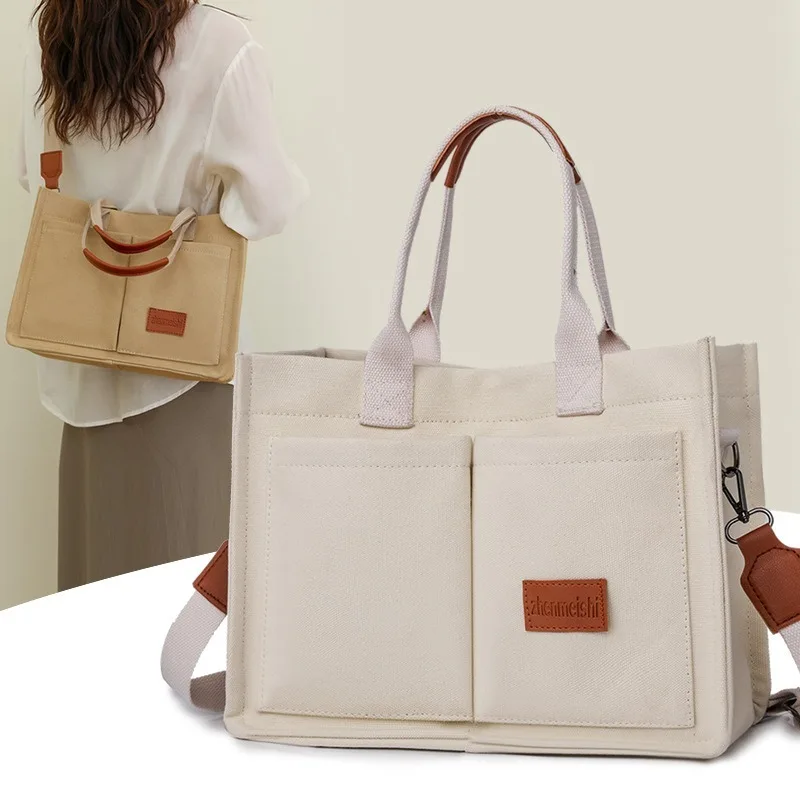
Finding Your Perfect Match: Decision Framework
Selecting between canvas and leather ultimately depends on aligning material properties with your specific needs and lifestyle. Consider these key factors when making your decision:
Usage Environment Analysis
* For corporate settings with formal dress codes, leather’s professional appearance often makes it the preferred choice.
* For creative workplaces, educational environments, or casual offices, canvas offers appropriate styling with practical benefits.
* For mixed environments, consider how frequently you need to make a formal impression versus practical everyday functionality.
Commuting Considerations
* Bicycle commuters often prefer lightweight canvas that can withstand occasional rough handling.
* Public transit commuters might value leather’s structured design that protects contents in crowded conditions.
* Walking commuters should weigh the comfort factor of canvas’s lighter weight against leather’s professional appearance.
Climate Compatibility
* In rainy regions, waxed canvas or specially treated leather offers the best protection.
* In hot, humid environments, canvas breathes better and doesn’t show water spots from perspiration.
* In variable conditions, canvas generally requires less protection from the elements.
Budget Realities
* Initial investment: Canvas offers quality options at lower price points.
* Lifetime value: Premium leather can offer decades of use with proper care.
* Replacement frequency: Consider whether one well-maintained leather bag might outlast several canvas bags.
Maintenance Willingness
* Minimal maintenance preference: Canvas requires little specialized care.
* Willing to perform regular maintenance: Leather rewards care with improved appearance over time.
Making the right decision for your perfect daily messenger bag requires honest assessment of these practical factors alongside your aesthetic preferences.
Which Material Suits Different Lifestyles?
Different professional paths and personal lifestyles naturally align better with either canvas or leather messenger bags. Consider these scenarios to identify which material might better complement your daily life:
Canvas Messenger Bags Ideal For:
Active Urban Commuters: Graphic designers, teachers, or tech workers navigating city environments by bike, foot, or public transit appreciate canvas’s lightweight construction and resilience to rough handling.
Frequent Travelers: Those regularly passing through airports value canvas bags for their lighter weight when rushing between terminals and their ability to compress slightly to fit in overhead compartments or under seats.
Outdoor-Adjacent Professionals: Environmental scientists, landscape architects, or construction managers who transition between office settings and field locations benefit from canvas’s durability in varied environments.
Parents with Professional Lives: Those balancing career responsibilities with family needs find canvas bags better withstand the occasional spill or unexpected use as an impromptu diaper bag or snack carrier.
Budget-Conscious Young Professionals: Entry-level workers building their professional wardrobe find canvas offers a sophisticated option without the significant investment leather requires.
Leather Messenger Bags Ideal For:
Corporate Executives: Those in leadership positions where appearance directly impacts perception benefit from leather’s refined professional aesthetics during meetings, presentations, and client interactions.
Legal, Financial, or Consulting Professionals: Workers in traditional professional services where formality remains important find leather bags complement their required attire while making an appropriate impression.
Minimal Carry Individuals: People who carry relatively few items daily experience less weight penalty from leather while benefiting from its superior structure and organization.
Long-Term Investment Shoppers: Those who prefer buying quality items infrequently rather than replacing items regularly appreciate leather’s potential decade-plus lifespan with proper care.
Professional Image Cultivators: Workers in competitive fields where details matter find leather bags contribute positively to their carefully curated professional presentation.
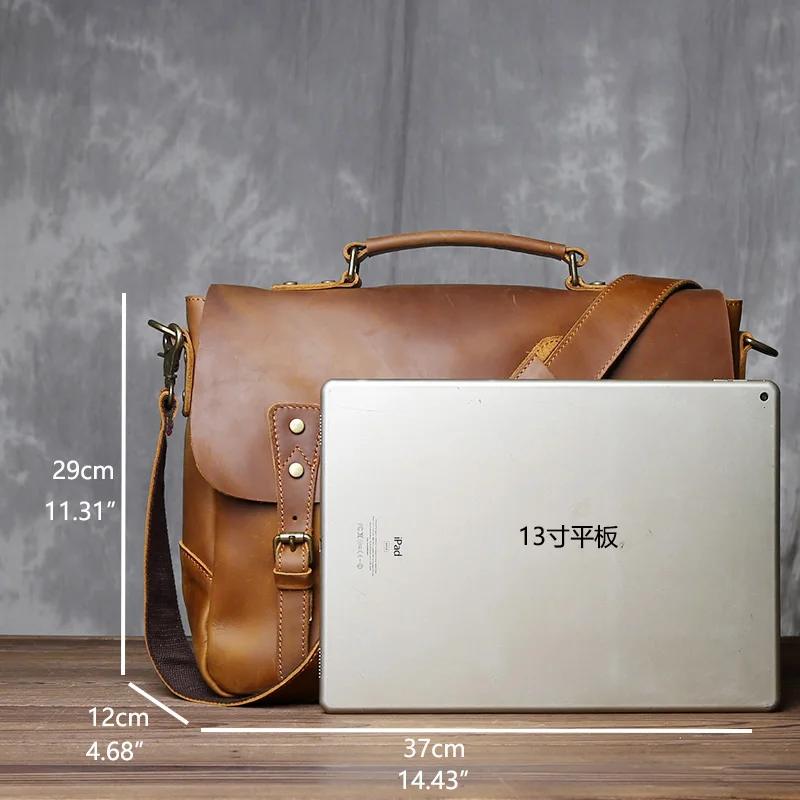
The right choice depends on your specific circumstances, but understanding these typical patterns can help identify which material might naturally align with your vintage-style messenger bag needs or contemporary professional requirements.
Care and Maintenance: Extending the Life of Your Messenger Bag
Canvas Bag Care
Proper maintenance significantly extends the life of canvas messenger bags:
Routine Cleaning: Brush off surface dirt regularly with a soft-bristled brush. For deeper cleaning, use mild soap and lukewarm water applied with a soft cloth, gently scrubbing stained areas.
Spot Treatment: Address spills immediately by blotting (not rubbing) with a clean, absorbent cloth. For stubborn stains, create a paste with baking soda and water, apply to the stain, let dry completely, then brush away.
Waxed Canvas Refreshing: Rejuvenate waxed canvas by applying appropriate wax with a clean cloth using circular motions, then gently heating with a hairdryer to help the wax penetrate the fibers. Allow 24 hours to cure before using.
Proper Storage: Store canvas bags in a cool, dry place away from direct sunlight. Insert crumpled acid-free paper to maintain shape and avoid crushing.
Leather Bag Care
Leather requires more specialized but ultimately rewarding care:
Regular Conditioning: Apply quality leather conditioner every 3-6 months (more frequently in dry climates) to prevent cracking and maintain suppleness. Use products specifically formulated for your leather type.
Cleaning Process: Wipe with a slightly damp cloth for routine cleaning. For more thorough cleaning, use leather-specific cleaners that won’t strip natural oils. Knowing how to properly clean stains from leather bags prevents permanent damage.
Handling Water Exposure: If your leather bag gets wet, blot excess moisture immediately with a dry cloth, stuff with paper to maintain shape, and allow to dry naturally away from direct heat sources. Once dry, condition to restore moisture balance.
Protective Measures: Apply leather protectant products to create a barrier against water and stains. Test on an inconspicuous area first to ensure it doesn’t alter the color or finish.
Professional Restoration: Consider professional leather restoration services for addressing significant wear, color restoration, or structural repairs to extend your bag’s life indefinitely.
Canvas & Leather Messenger Bag, Leather Commuter Tote
$80.41 Select options This product has multiple variants. The options may be chosen on the product pageCrazy Horse Leather Satchel, Men's Leather Satchel, Men's Professional Leather Messenger, Vintage Style Messenger Bag
$132.70 Select options This product has multiple variants. The options may be chosen on the product pageBrown Leather Messenger Bag, Men's Leather Satchel, Men's Professional Leather Messenger
$118.87 Select options This product has multiple variants. The options may be chosen on the product pageBlack Leather Messenger Bag, Black Leather Work Tote, Faux Leather Work Tote
$101.88 Select options This product has multiple variants. The options may be chosen on the product pageCrazy Horse Leather Satchel, Full Grain Messenger Bag, Men's Leather Satchel
$430.41 Select options This product has multiple variants. The options may be chosen on the product pageCrazy Horse Leather Satchel, Men's Classic Leather Briefcase, Professional Laptop Messenger
Price range: $460.43 through $536.25 Select options This product has multiple variants. The options may be chosen on the product page
Are Hybrid Canvas-Leather Bags the Best of Both Worlds?
Hybrid messenger bags that combine canvas bodies with leather trim and accents present an intriguing middle ground between the two materials. These designs strategically use leather for high-wear areas like bottoms, straps, and closures while utilizing canvas for the main body to reduce weight and cost.
The aesthetic advantage of hybrid bags is significant—they create visual interest through material contrast while projecting a sophisticated yet approachable image. This balanced appearance makes them particularly versatile across different environments, from creative offices to academic settings to casual business meetings.
From a practical perspective, hybrid bags often achieve an ideal weight-to-durability ratio. The canvas body keeps the overall weight manageable, while leather reinforcements protect the areas most susceptible to wear. Additionally, hybrid bags typically fall between all-canvas and all-leather options in price, offering a premium feel without the full investment of an all-leather bag.
However, hybrid designs do require understanding both canvas and leather care techniques. The combination also means that the bag will age at different rates—leather portions will develop patina while canvas areas may fade or wear differently. For many users, this evolving character becomes part of the appeal.
Our collection of leather messenger bags includes several hybrid options that balance the benefits of both materials.
What About Environmental and Ethical Considerations?
When choosing between canvas and leather messenger bags, environmental and ethical factors increasingly influence consumer decisions:
Canvas Environmental Considerations:
* Derived from plant fibers (typically cotton or linen), making it a renewable resource
* Processing requires water and potentially pesticides, though organic options minimize environmental impact
* Generally biodegradable at end-of-life, particularly with natural fibers and minimal treatments
* Recycled canvas options repurpose existing materials, reducing waste and resource consumption
* Lower environmental footprint in production but potentially higher if frequently replaced
Leather Environmental Considerations:
* As a byproduct of the meat industry, utilizes materials that might otherwise become waste
* Tanning process traditionally uses chromium and other chemicals with potential environmental impacts
* Vegetable-tanned leather uses plant-based tannins, significantly reducing toxic chemical use
* Exceptional longevity means fewer replacements over time, potentially reducing lifetime resource consumption
* Proper care and repair can extend useful life for decades, minimizing waste
For those seeking alternatives to traditional leather, vegan leather messenger bags offer animal-free options with varying environmental profiles. These alternatives range from plastic-derived materials to innovative plant-based options using pineapple leaves, apple peels, or mushroom mycelium.
When making your choice, consider not just the initial production impact but the entire lifecycle of the product, including how long it will serve your needs before requiring replacement.
Will Your Canvas or Leather Messenger Bag Last Longer?
The durability question ultimately depends on how we define “lasting.” Canvas and leather demonstrate different types of longevity that should inform your decision:
Canvas bags excel in abrasion resistance and typically handle rough everyday treatment well. A quality canvas messenger bag with proper care can reasonably last 3-7 years of regular use before showing significant wear. Canvas typically fails gradually—small frays, worn spots, or faded areas develop over time while the bag remains functionally useful.
Leather, conversely, offers superior structural longevity. A well-made, full-grain leather messenger bag can literally last decades—even generations—with appropriate care. The durability of leather versus canvas bags is particularly evident in how they age: leather typically remains functional longer but shows cosmetic aging through patina development that many find desirable.
Factors significantly affecting longevity include:
Construction Quality: Double-stitched seams, quality hardware, and reinforced stress points extend the life of both materials.
Usage Patterns: Daily commuting in harsh conditions will wear out either material faster than occasional use.
Maintenance Consistency: Regular appropriate care dramatically extends the useful life of both materials, though leather requires more consistent attention.
Carrying Weight: Routinely overloading any bag stresses seams and attachment points regardless of material.
For maximum longevity, look for quality indicators like YKK zippers, marine-grade thread, copper or brass hardware, and reinforced rivets at stress points. These construction elements often prove more important to overall durability than the base material itself.
While canvas and leather messenger bags each offer distinct advantages, your ideal choice ultimately depends on your personal priorities, professional environment, and lifestyle needs. Whether you prioritize lightweight practicality or timeless elegance, understanding these material differences ensures you’ll select a messenger bag that serves you well for years to come.

